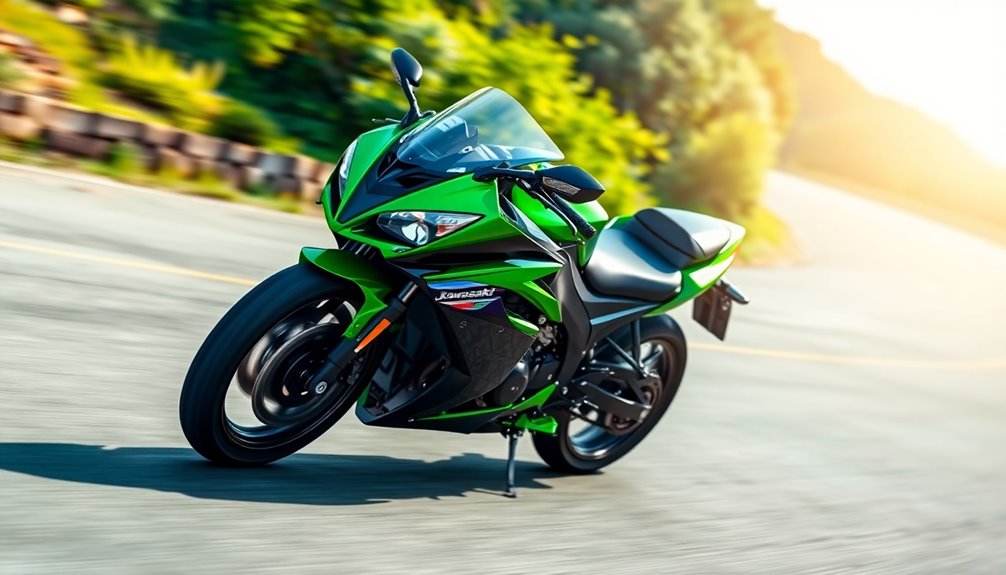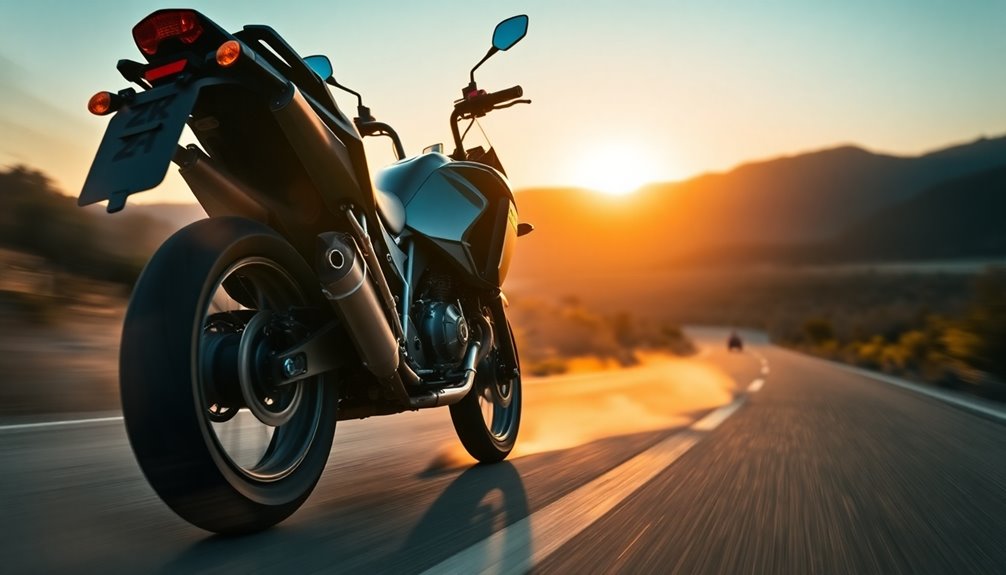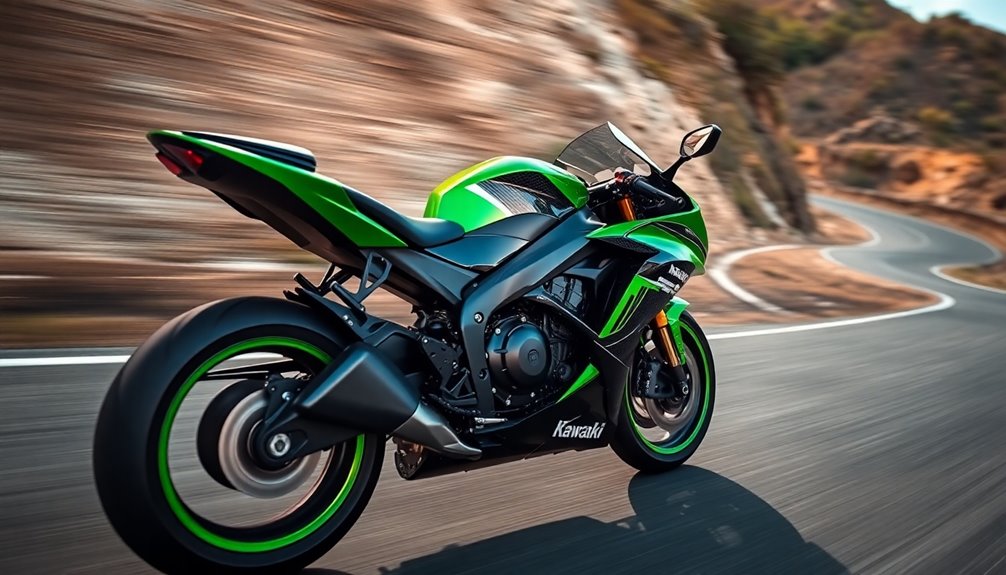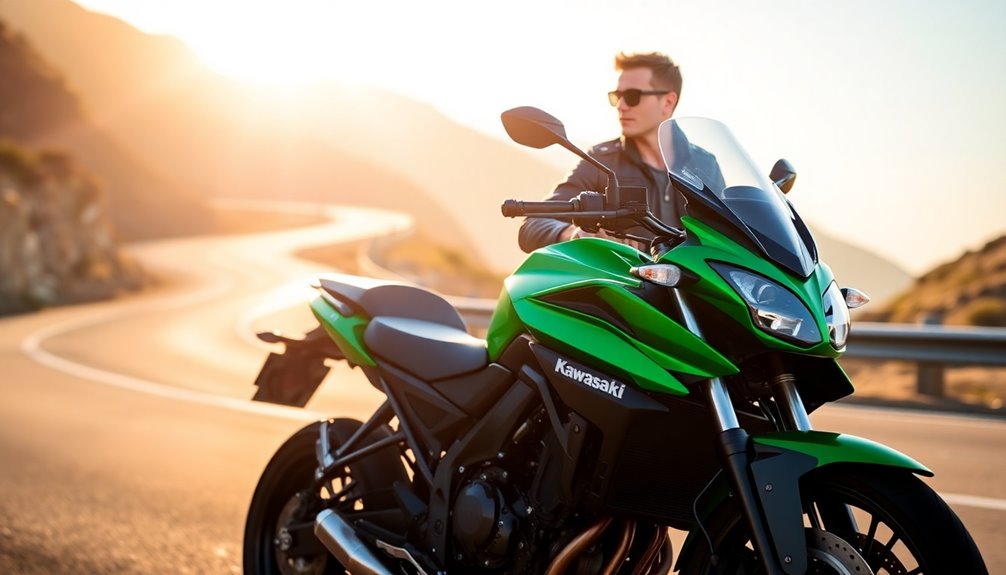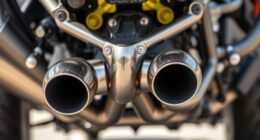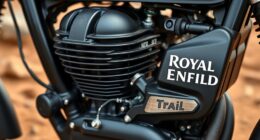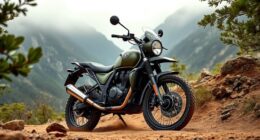The Kawasaki Ninja 250R hits a top speed of around 97.56 mph, making it perfect for beginners who want a sport bike without overwhelming power. Its lightweight frame and comfortable ergonomics promote confident riding, while the 249cc engine delivers a solid 31 hp. You'll appreciate the agile handling, especially in urban environments. Maintenance is straightforward, ensuring it remains a reliable option for new riders. Plus, its affordability adds to its appeal against competitors. If you're curious about how it compares to other models or want tips for enhancing your experience, there's more to explore.
Key Takeaways
- The Kawasaki Ninja 250R has a top speed of approximately 97.56 mph, with realistic speeds around 90 mph.
- It features a 249cc liquid-cooled engine that delivers 31 hp at 11,000 rpm.
- Acceleration metrics show 0-60 mph in 7.08 seconds and a quarter mile in about 15.86 seconds.
- Its lightweight design and balanced ergonomics make it an ideal choice for beginner riders.
- The Ninja 250R competes effectively in its class against models like the Honda CBR250R and Yamaha WR250X.
Lightweight Chassis Design
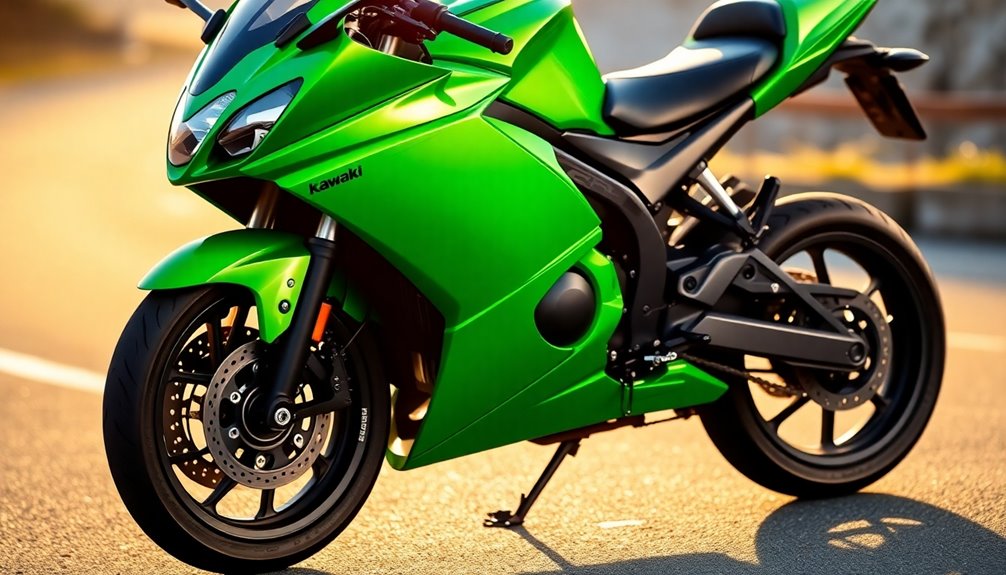
In designing the Kawasaki Ninja 250R, engineers focused on a lightweight chassis that enhances both performance and handling. The motorcycle features a diamond-shaped steel frame, crafted with a tubular diamond design that contributes to superior riding dynamics. This frame design optimizes mass centralization, allowing for agile maneuvering and responsive handling, making your ride more enjoyable.
Weighing in at 138 kg (304 lbs) dry and 160 kg (355 lbs) wet, the Ninja 250R manages to strike an impressive balance. The narrow parallel twin-cylinder engine and compact frame help keep the weight low, ensuring that you'll feel confident and stable on the road. Additionally, the bike's engine specifications highlight its strong performance at low and mid-range speeds, catering to novice riders seeking versatility.
With a modest seat height and slightly elevated handlebars, this bike offers comfort and balance, enhancing your control during every twist and turn.
The suspension system, featuring telescopic forks at the front and a UNI-TRAK single shock at the rear, provides excellent travel for a smooth ride. Coupled with petal disk brakes, the chassis is designed to deliver stable and effective braking performance.
Engine Efficiency Insights
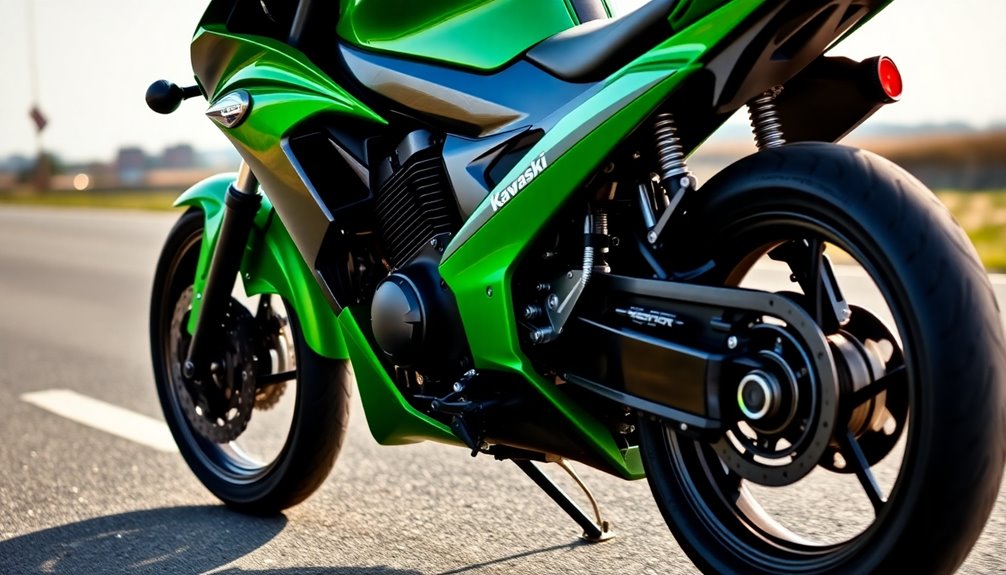
When you push the Kawasaki Ninja 250R to its limits, you'll notice how engine efficiency plays a crucial role in achieving maximum velocity. Its responsive throttle and aerodynamic fairing design not only enhance speed but also improve overall performance. Additionally, the bike features a 249cc liquid-cooled engine, which contributes to its impressive capabilities on the road. Let's explore how these factors contribute to the bike's impressive capabilities on the road.
Maximum Velocity Achieved
Achieving a top speed of 97.56 mph, the Kawasaki Ninja 250R showcases impressive engine efficiency for a 250 cc motorcycle. You can reach this peak velocity in about 50 seconds from a complete stop, demonstrating its capability in real-world conditions.
However, when you ride normally, expect a more realistic top speed of around 90 mph due to the speedometer's tendency to over-read by 10-15%.
With a power output of 31 hp at 11,000 rpm and torque of 21 Nm at 8,500 rpm, the Ninja 250R offers a smooth and responsive ride, especially with its electronic fuel injection. This bike has historically been considered quick for its class, but it now faces competition from larger models that offer more power.
However, it faces limitations as power tails off above 13,000 rpm, and maintaining higher speeds can be challenging, particularly above 80 mph.
Frequent gear shifts are necessary to keep up with faster traffic, especially on highways where the Ninja 250R might struggle.
In terms of acceleration, it completes a quarter mile in about 15.86 seconds, reaching 83.7 mph.
Compared to larger vehicles, like the Volkswagen Tiguan 2.0T, the Ninja 250R remains competitive but less so in today's market.
Throttle Response Characteristics
To tackle these throttle response issues, consider cleaning the carbs or adjusting the chain tension. Some riders even shim the cush drive for better alignment. However, results can vary, and you might still feel the effects of these throttle quirks depending on your riding style and conditions. Addressing throttle cable slack can also significantly improve the smoothness of acceleration.
Aerodynamic Fairing Design
The Ninja 250R's aerodynamic fairing design significantly enhances both its performance and efficiency. With a full fairing that mirrors the style of larger Kawasaki sportbikes, this design helps reduce air resistance, allowing you to experience improved stability at higher speeds.
You'll appreciate how the more enclosed bodywork not only looks stylish but also enables the bike to slice through the air, boosting your top speed and handling. Moreover, the design's ability to enhance temperature regulation contributes to maintaining optimal engine performance during rides. The use of refrigerants in heat pumps plays a crucial role in absorbing and releasing heat, similar to how the fairing helps manage airflow around the engine. Furthermore, the incorporation of smart technology in modern systems ensures that energy consumption is optimized, paralleling the efficiency seen in the Ninja 250R's design. Additionally, the importance of proper ventilation in various systems is mirrored in the Ninja's design, as it allows for effective airflow around the engine, promoting performance.
The fairing's dual headlights, though some models have switched to a single headlight, add to the sleek aesthetics while maintaining function. The liquid-cooled engine paired with this aerodynamic design ensures consistent temperatures, contributing to long engine life and sustained power. Additionally, the Ninja 250R's fuel efficiency of 70 to 75 miles per gallon showcases its ability to perform well without sacrificing economy.
Tighter engine clearances enhance performance by increasing power and minimizing noise, making your rides smoother.
The high-revving engine, with a 13,000-rpm redline and four valves per cylinder, maximizes airflow for excellent low-end torque and high-rpm power delivery.
Combined with a six-speed transmission and improved suspension, the Ninja 250R offers predictable power and superior handling, making it an ideal choice for both new and experienced riders.
Rider Comfort and Ergonomics
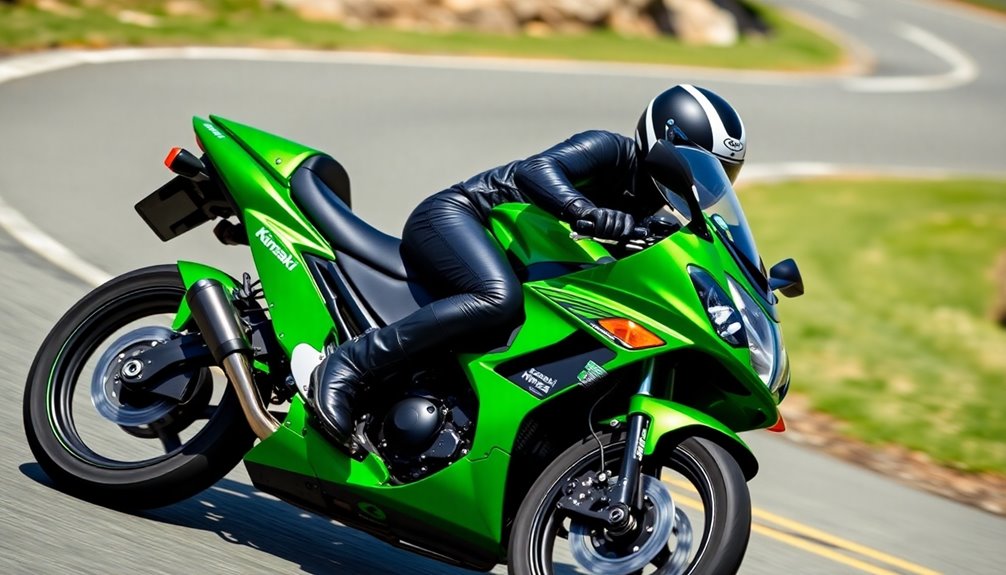
Rider comfort and ergonomics play a crucial role in enhancing your experience on the Kawasaki Ninja 250R. This bike features a natural riding position with a slightly forward-slanting seat, which helps you maintain an upright posture. The wide, raised handlebars contribute significantly to your comfort, reducing strain during rides. Unlike many sportbikes, you won't feel folded up, making it a great choice if you're taller.
While the stock seat is designed for sportiness, you might find it less comfortable on long trips. Luckily, there's an optional gel comfort seat that's 15mm taller, providing better support and alleviating pressure points. The wind protection isn't extensive, but the fairing and windscreen do a decent job of deflecting wind, enhancing your overall ride. Additionally, taller riders over 6'2" often express the need for modifications in seat height to improve their comfort during longer rides.
Handling is where the Ninja 250R truly shines. Its lightweight frame and agile nature give you confidence on the road. The sturdy diamond-style frame and advanced suspension work together to ensure stability and control, allowing you to navigate corners with ease.
Owner Experiences: Insights Shared
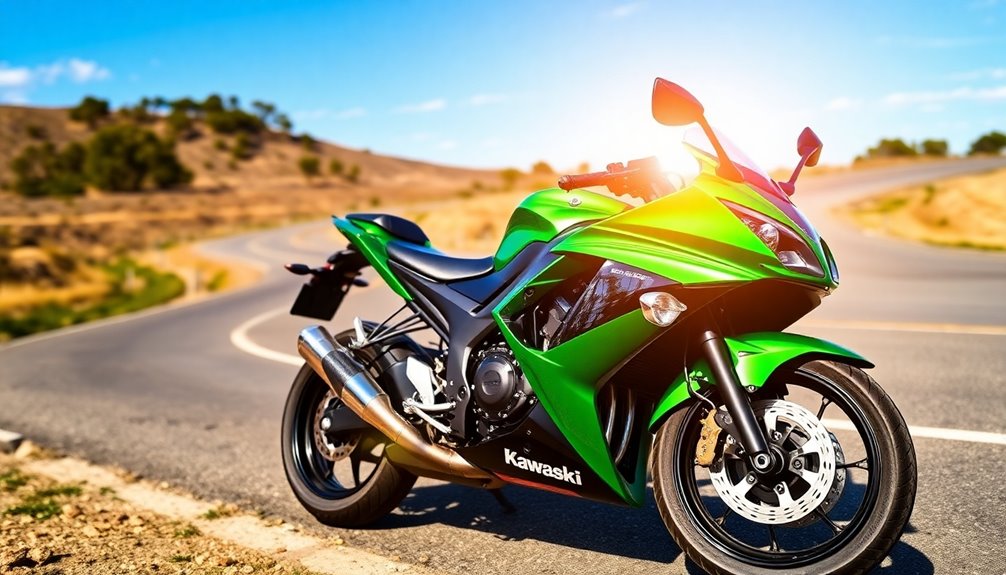
Many owners of the Kawasaki Ninja 250R share a common bond through their experiences, highlighting the bike's blend of performance and practicality.
You'll appreciate the impressive acceleration, hitting 0-60 mph in just 7.08 seconds and covering a quarter mile in 15.86 seconds. The bike's top speed ranges from 92 to 97.7 mph, depending on conditions, making it a thrilling ride for both new and experienced riders.
Handling is where the Ninja 250R truly shines. Its lightweight construction allows for agile cornering, and you'll find high-speed stability reassuring, with minimal vibration. Many riders note that the handling capabilities of the Ninja 250R make it feel like a much larger sport bike in urban environments.
The 250 cc twin-cylinder engine, producing 32 horsepower, delivers smooth power, especially above 6,000 RPM.
Braking is reliable, thanks to disc brakes on both tires, instilling confidence even during panic stops. Owners emphasize the importance of safety gear and respecting the bike's power for safe riding.
Maintenance is straightforward, ensuring longevity, and the bike's fuel efficiency of 48-55 mpg makes it a practical choice for daily commutes.
Market Positioning Among Rivals

In a competitive landscape, the Kawasaki Ninja 250R stands out against its rivals by offering a unique combination of power, design, and price. With a twin-cylinder engine producing 26.09 hp and 15.02 ft/lb of torque, it outperforms the single-cylinder Honda CBR250R, especially when it comes to passing power.
While the Yamaha WR250X boasts higher max power and torque, the Ninja 250R accelerates more effectively, making it a formidable choice for beginners. Additionally, both bikes offer versatility and performance across various terrains, catering to different riding preferences. The Ninja 250R's ability to maintain color accuracy in its design aesthetic enhances its appeal to sport bike enthusiasts. Furthermore, the bike's lightweight design contributes to its nimble handling, allowing riders to maneuver with ease. Investing in a sport bike like the Ninja 250R can enhance your overall financial health by providing an enjoyable and cost-effective mode of transportation. Maintaining proper tire pressure is crucial for optimal performance and safety, which is especially important for new riders.
In terms of engine technology, the Ninja 250R features dual carburetors in the U.S., though it's available with fuel injection in other markets, giving it a smoother ride compared to its competition.
The bike's design blends the best of standard and sport ergonomics, with a comfortable seat height of 30.5 inches and a lower center of gravity than the WR250X.
When it comes to pricing, the Ninja 250R's base price of around $3,999 puts it in a competitive position, especially since it's one of Kawasaki's best-sellers.
With its legacy dating back to 1986 and few significant changes, the Ninja 250R continues to influence the market for beginner sport bikes.
Performance Exhaust System Enhancements

Upgrading to a performance exhaust system can significantly enhance your Kawasaki Ninja 250R's capabilities. By reducing backpressure and improving engine breathing, you could see a noticeable power increase.
While the exact gain varies, a tuned Ninja 250R with a performance exhaust can achieve up to 35.92 bhp and 16.79 lb-ft of torque, compared to the standard models producing around 25.6 bhp and 13 lb-ft. This boost in torque enhances your bike's mid-range performance and responsiveness, which is especially beneficial when navigating twisty roads. You'll notice improved acceleration and handling, making your rides more engaging.
Plus, lightweight performance exhaust systems reduce overall weight, further enhancing handling. Installing a compatible performance exhaust, like those from Akrapovič, is crucial. These systems are designed specifically for the Ninja 250R, ensuring they fit well with your bike's engine and chassis.
Proper installation is key to meeting emission standards and maintaining reliability. With the right exhaust system, you'll not only elevate your bike's performance but also enjoy a more thrilling riding experience. Additionally, significant power gains are possible with tuning, such as breathing work yielding up to 40% power increase without engine swaps.
Cost and Dealer Options
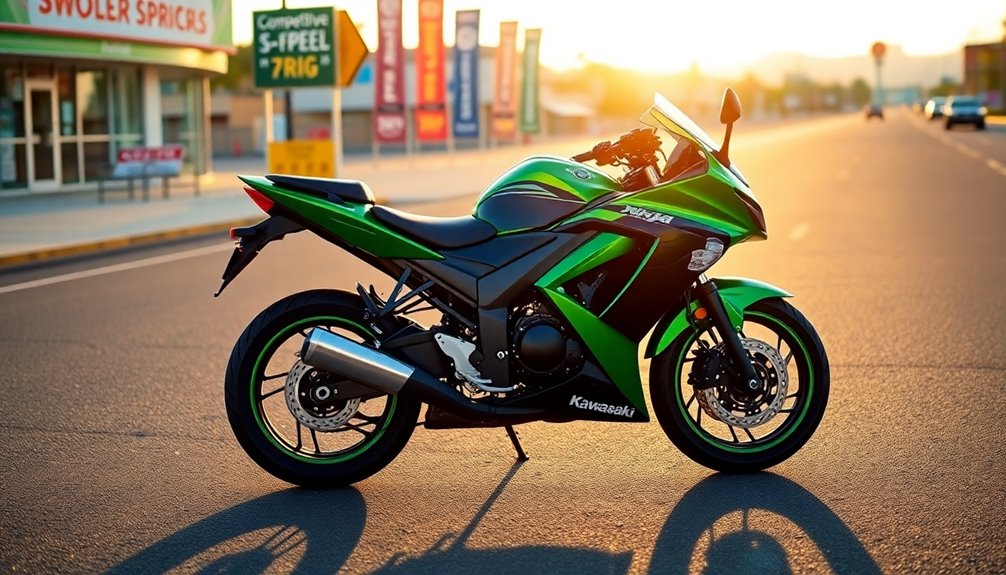
When considering the cost of a Kawasaki Ninja 250R, you'll find a range of options that can fit various budgets. A brand new model typically costs around $3,000, but used models can vary significantly based on condition and mileage. For instance, a 2004 model with nearly 10,000 miles might be labeled as an "Opportunity Vehicle" due to minor issues, often leading to a lower price. Fuel efficiency is another plus, getting about 50-60 miles per gallon, which helps keep your operating costs down. Maintenance is low, too, since the Ninja 250R has few mechanical adjustments needed and reliable parts availability. Additionally, the Ninja series is known for its advanced technology that enhances performance and rider control, making it a popular choice among beginners. You'll discover plenty of dealer options, both from various dealerships and private sellers. Some dealers offer fully serviced bikes with warranties, while others might sell them "as-is" at a discount. It's worth noting that some dealers don't charge dealer fees, which can help reduce your overall costs. Lastly, keep an eye out for financing options and promotions on older models, as these can make your purchase even more manageable.
New Riders Seeking Agility
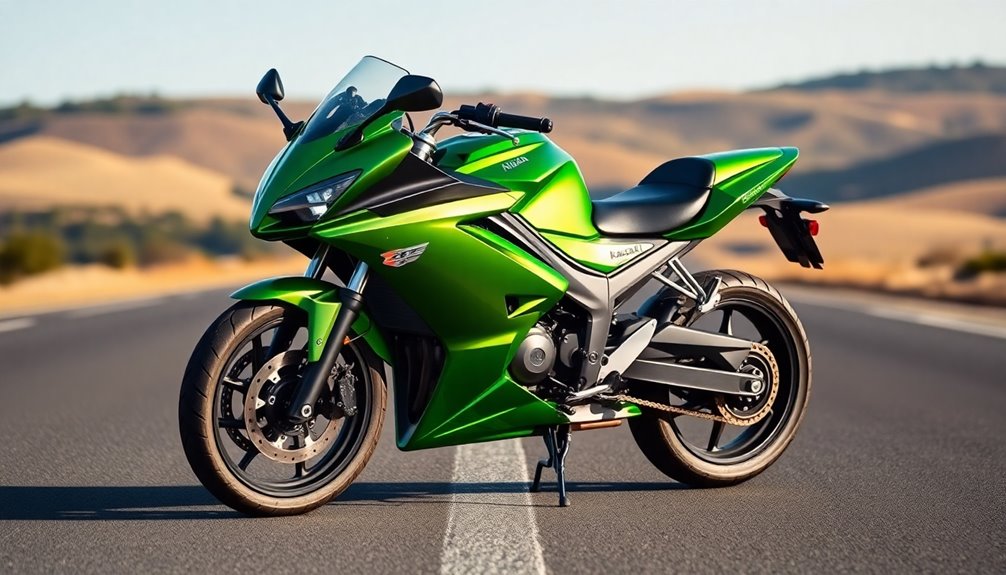
Agility is a key trait that new riders often seek in their first motorcycle, and the Kawasaki Ninja 250R delivers on this front with its lightweight design and responsive handling. Weighing in at just 304 pounds, this bike offers superb mass centralization, making it easy to maneuver through traffic or tight corners. Additionally, many riders find that a motorcycle's astrological compatibility with their personality can enhance their overall riding experience. Regular practice of nighttime meditation can also help riders improve their focus and mental clarity while on the road.
The low seat height enhances your confidence when stopping, allowing you to plant your feet firmly on the ground.
The Ninja 250R's suspension, featuring Kawasaki's UNI-TRAK® system, provides a smooth and controlled ride, ensuring you feel stable and comfortable even on uneven surfaces. Its high-performance disc brakes lend you the stopping power you need, boosting your confidence as you navigate various riding conditions.
With a six-speed transmission, you'll enjoy excellent acceleration and relaxed highway cruising. The bike's mid-range power improves low-speed performance, making it perfect for urban environments. Additionally, the Ninja 250R is equipped with a liquid-cooled engine, which enhances its overall performance and reliability.
Plus, the flickable nature of the Ninja 250R encourages you to explore and push your limits, making it an ideal choice for new riders seeking agility in their first motorcycle.
Frequent Maintenance Requirements
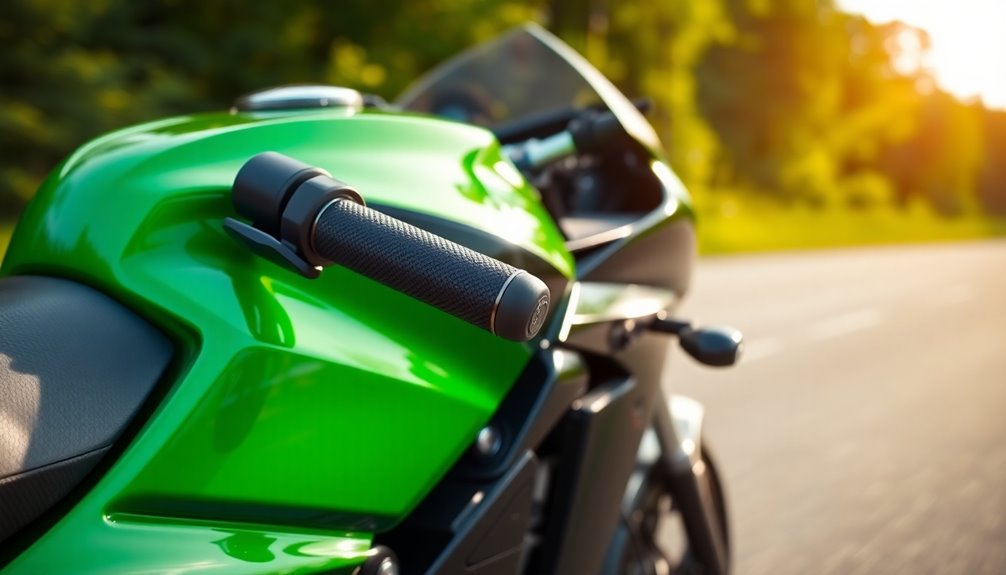
Regular maintenance is crucial for keeping your Kawasaki Ninja 250R running smoothly and efficiently.
Start with the oil and filter—change them every 7,500 miles or annually, using 10W-40 oil like Motul 5100. Remember to replace the oil filter at each service interval. If you ride aggressively, consider changing the oil more frequently.
Next, check your valve clearances and adjust them every 7,500 miles. Inspect engine vacuum synchronization and clean spark plugs every 6,000 miles.
Don't forget to check the throttle grip play and fuel system for leaks during each service.
For brakes and coolant, change the brake fluid every two years and replace hoses every four years. The coolant should be changed every three years, along with radiator hoses and O-rings. Additionally, ensure regular replacement of brake fluid and coolant to maintain optimal performance.
Inspect the brake fluid level every six months.
Lastly, maintain your chain by lubricating it every 400 miles and adjusting slack every 600 miles. Lubricate the swingarm pivot at each service, and check the steering stem bearings every two years.
Staying on top of these maintenance tasks will ensure your Ninja 250R performs at its best.
Robust Braking System Features

The Kawasaki Ninja 250R boasts a robust braking system designed to enhance rider confidence and control. At the front, you'll find a single hydraulic disc brake that provides quick responsiveness, especially in emergency situations.
While the standard model lacks ABS, some later variants include it, which greatly improves safety during hard braking. Additionally, the Ninja 300's standard ABS feature offers even more safety during emergency braking scenarios.
The rear brake employs a linked system that engages both front and rear calipers, making it easier for you to manage braking. When you pull the front brake lever, it operates the front caliper independently, allowing for precise control.
However, using the rear pedal firmly can cause excessive front-end dive, so it's essential to find a balanced technique.
This braking system is user-friendly, which is ideal for beginner riders. Its predictable behavior helps maintain stability during braking, ensuring you feel secure on the road.
While it may not have the finesse of more advanced models, the Ninja 250R's braking performance is adequate for its power and speed.
Enduring Popularity Among Beginners
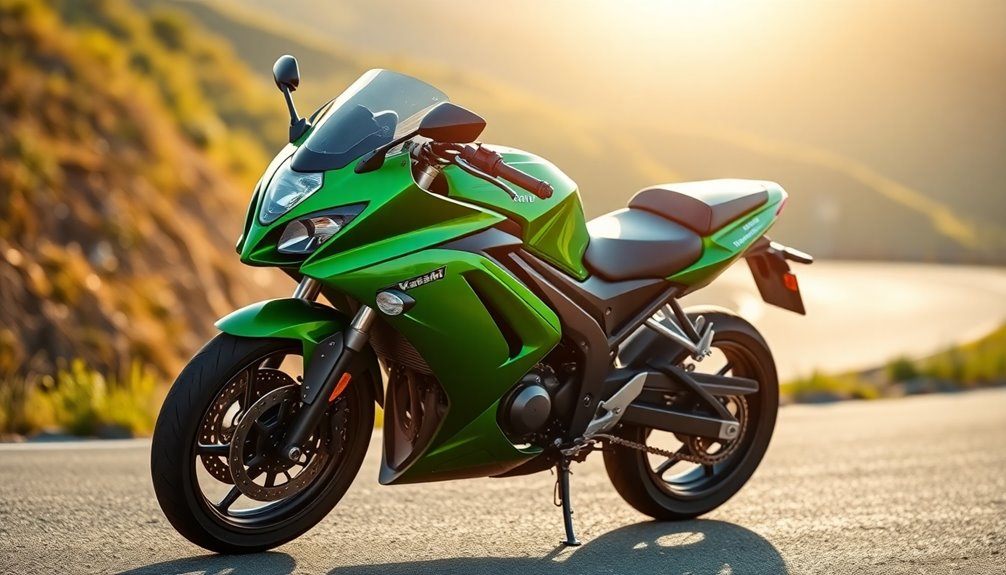
For many new riders, the Kawasaki Ninja 250R stands out as an excellent choice due to its blend of user-friendly features and engaging performance. Its ergonomics make it particularly appealing; with wider, higher handlebars and a relatively low seat height of 30.5 inches, you'll find it comfortable and accessible. Incorporating regular physical activity is essential for overall health, which can also enhance your riding experience. Engaging in activities like hula hooping can improve core strength and stability, further benefiting your riding posture. Additionally, mindfulness practices can help riders maintain focus and reduce anxiety while on the road.
Weighing just 335 pounds, lifting it off the kickstand is a breeze, which is crucial for those still gaining confidence. The engine delivers impressive performance for a 250cc bike, featuring 70% updates in the 2008 model that enhance low and midrange torque. You'll appreciate the smooth acceleration as it goes from 0-60 mph in just 7 seconds, perfect for navigating city streets or the freeway. The bike's forgiving nature makes it ideal for beginners, allowing you to focus on mastering your skills without feeling overwhelmed by power. Additionally, the importance of long-term financial planning for maintenance and potential upgrades can help ensure that your investment in the Ninja 250R remains rewarding over time.
Additionally, the Ninja 250R's fuel efficiency of approximately 70 miles per gallon makes it a practical option for daily commuting. With a large community for support and customization, along with ease of maintenance, the Ninja 250R proves durable and reliable for long-term use.
These factors contribute to its enduring popularity among newcomers, ensuring it remains a top choice in the beginner sport bike category.
Frequently Asked Questions
What Is the Top Speed of the Kawasaki Ninja 250R?
The top speed of the Kawasaki Ninja 250R is about 97.56 mph, although in real-world conditions, you'll likely see around 90 mph.
Keep in mind that the speedometer can be inaccurate, sometimes showing up to 110 mph.
You can reach this top speed in roughly 50 seconds from a standstill, which is impressive for a beginner sport bike.
How Does the Ninja 250R Compare to Newer Models?
When you compare the Ninja 250R to newer models like the Ninja 300, you'll notice significant upgrades.
The Ninja 300 offers more horsepower, better handling with sharper turn-in, and advanced features like fuel injection and ABS.
While the 250R has a respectable top speed of around 90 mph, the Ninja 300 surpasses that, providing a more thrilling ride.
What Are the Best Modifications for Improved Speed?
To improve speed, start by upgrading your exhaust system for better airflow.
Install a high-performance air filter and consider tuning your fuel injection or re-jetting your carbs.
Lightweight components can reduce overall weight, enhancing power-to-weight ratio.
Adjust your gear ratios for optimal power delivery, and don't forget about tire upgrades for better grip.
Lastly, tweak your suspension settings to ensure stability at higher speeds.
These modifications will significantly boost your bike's performance.
Is the Ninja 250R Reliable for Long-Distance Rides?
Absolutely, the Ninja 250R's known for its reliability on long-distance rides.
With its robust engine and impressive fuel efficiency, you'll find it economical for extended journeys. Maintenance is straightforward, ensuring you can keep it running smoothly.
Plus, its lightweight design makes it easy to handle, even after hours on the road. Just keep an eye on your fuel levels, as it doesn't come with a gauge, and you'll be good to go!
What Safety Features Does the Ninja 250R Include?
The Ninja 250R boasts several impressive safety features to enhance your riding experience.
You'll find ABS for better braking control, along with riding modes like Sport and Road to adapt to different conditions.
The LED headlamp and tail lamp improve visibility at night, while the engine check warning keeps you informed about your bike's health.
Additionally, side reflectors help increase your presence on the road, ensuring you ride safely.

